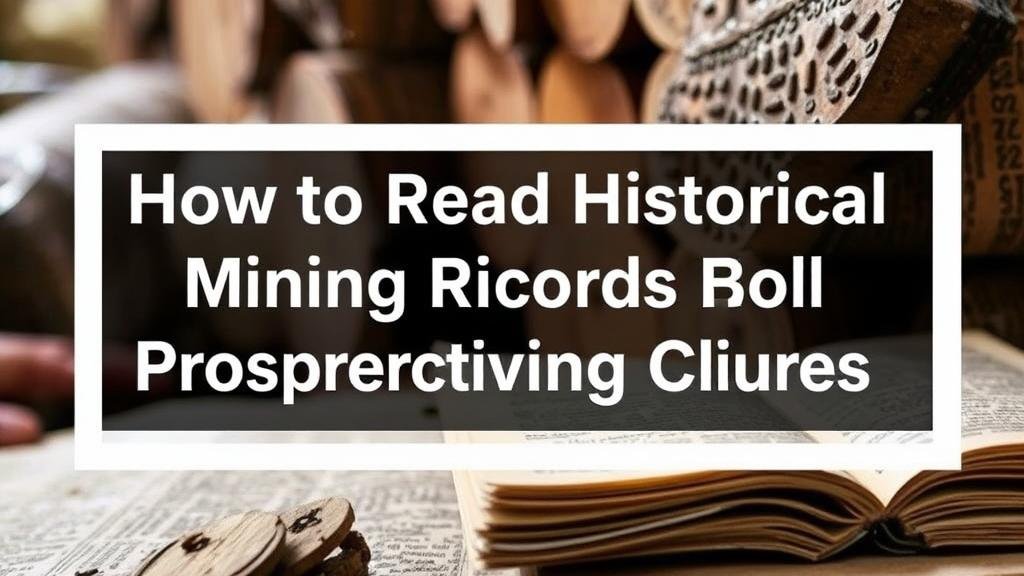How to Read Historical Mining Records for Gold Prospecting Clues
How to Read Historical Mining Records for Gold Prospecting Clues
Understanding historical mining records is essential for any serious gold prospector. These documents provide invaluable insights into past mining activities, helping modern prospectors identify potentially lucrative areas for exploration. This article will guide you through the process of reading and interpreting historical mining records, enabling you to leverage them in your own gold prospecting endeavors.
The Importance of Historical Mining Records
Historical mining records serve as a treasure trove of information. not only detail where gold was mined in the past but also how successful those efforts were. Accessing these records can provide clues about:
- Potential gold locations
- Mining techniques used
- Geological formations of interest
For example, in California’s Gold Rush era, miners documented their yields, which can inform modern prospectors about effective locations and methods. According to the United States Geological Survey (USGS), over 750,000 ounces of gold were mined in California between 1848 and 1855, information like this can guide current explorations.
Types of Mining Records
Several types of mining records can be accessed, each providing unique insights:
- Assessment Reports: Detailed evaluations of mining areas and their potential.
- Mining Claims: Records indicating who claimed what and when, along with maps of claimed areas.
- Production Reports: Documentation of gold quantities extracted from various sites.
- Geological Surveys: Maps and reports detailing the geological characteristics of mining regions.
These records can often be found in local archives, state geological surveys, and libraries, making physical and digital research equally accessible.
How to Interpret Mining Records
Once you have located the appropriate records, understanding their content is key. Here are tips for interpretation:
- Read production numbers carefully: Check for significant yields that may indicate prolific mining spots.
- Analyze claim maps: Focus on areas with a high density of claims, as these often signify richer gold-bearing regions.
- Contextualize historical context: Understand the era and technology used during the mining activity to gauge its potential effectiveness.
For example, a production report might show that a specific area yielded several ounces of gold per week during a specific period. If that area has similar geological attributes today, it warrants further investigation.
Case Studies
Examining specific case studies can elucidate the practical applications of reading mining records. For example, in the Klondike Gold Rush of the late 1800s, prospectors subsequently utilized historical records of yields to discover new claims. By studying the success rates of previous operations, they identified areas that had been overlooked or underexplored due to antiquated methods or technological constraints.
Also, the discovery of gold in areas once abandoned can often be traced back to detailed reports by miners, which noted the presence of other minerals indicative of gold deposits. Todays prospectors can utilize these insights by re-evaluating these historical reports through the lens of modern technology.
Real-World Applications
The information gleaned from historical mining records can lead to actionable strategies for gold prospecting. Here are some ways to apply this knowledge:
- Site Selection: Prioritize locations with historical successes in gold mining.
- Technique Improvements: Adopt or adapt historical mining methods that proved effective for past prospectors.
- Geological Analysis: Conduct geological surveys based on historical observations to refine your prospecting efforts.
For example, a modern prospector studying the records of the Lost Horse Mine in California could replicate the high-yield conditions noted in reports to assess whether similar deposits exist in the surrounding areas.
Challenges and Considerations
While mining records are rich in information, several challenges persist:
- Inconsistent Data: Records may lack standardization, complicating comparisons across different sites or periods.
- Interpretation Errors: Misunderstanding the context or conditions of past mining can lead to poor decision-making.
- Overlooked Areas: Modern accessibility may result in the neglect of historically rich areas now obscured by regulations or land use changes.
Being aware of these challenges allows prospectors to adopt a more cautious and critical approach when extracting insights from historical mining records.
Conclusion
Reading and interpreting historical mining records is a powerful tool for gold prospectors. By leveraging the information within these documents, prospectors can identify promising locations and improve their chances of success. art of exploration is as much about understanding the past as it is about navigating the present, and with careful analysis of mining records, one can uncover a wealth of opportunities. Start your research today, and let the stories of the miners before you guide your prospecting journey.



